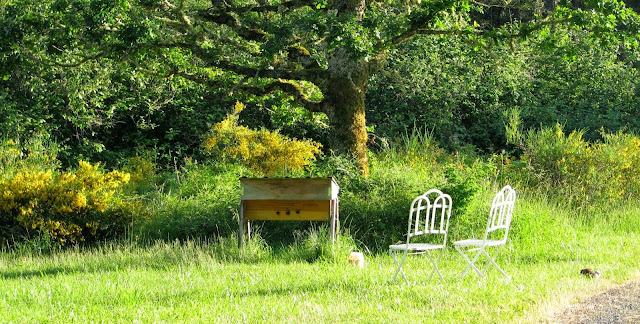This summer has been a lot of work for Buck and I. We have been so busy going back and forth this summer that not a lot has been done on the Homestead besides maintenance and winter readiness.
Because of the work we have done this summer, our other house where my dad, son and new daughter-in-law live, has an improved septic system and we have saved the garage from collapsing on a crumbling foundation. It is now a fully functioning art studio where no mice are allowed! This makes my new daughter in law a very happy painter.
We have also started work on the old barn on the property which has some sagging issues and a hole in the side where a hay door used to be. The door had been missing long before we bought it.
What shall we do with this frail old icon of our communities agricultural past? It would break our hearts to see it fall, but we can't justify too much money being spent on it for it's present use- storing outdoor furniture, 3 barn cats and a small amount of hay for my dads ancient (she turned 36 this year) Arab mare. Since we only have .5 acres of pasture, the barn will never really be used for much livestock or hay in the future.
It could be used for more- a workshop, art studio or maybe a farm store... It just needs to be re-purposed in some way. But for now we have to settle for just keeping it from falling down.
I drive by at least 15 barns on my way to the Homestead (a 15 mile drive) and every one but 2 of them are falling down. They are far too costly to repair when their original use is extinct. Sentimentality is a luxury few farms can afford these days. I know at least one farmer who found it was much cheaper and faster to replace the old wood barn with a steel building. The cost to fix the roof on the old barn would have cost the same as his whole new building. In my opinion, the very best hope for the survival of these old barns is to convert them to modern activities, not restore them as relics.
 |
| The underside of the barn is supported by peeled fir logs and 12 by 12's. There is something definitely wrong with the 12 by 12 in this picture. That's next on the list. |
It won't really look original, but the fact is that barns like this, built to house plow horses and the hay they ate in the winter, have no relevance in our modern lives. Keeping a barn interior dark was an important feature- the sun destroys the quality of hay, but more natural light would be a better feature for it's future.
We have had these turn of the century french doors out of an old factory for several years. We had planned on using them to enclose a porch, but changed our minds.
I did a lot of image searches for old barn windows and found that most old barn windows were just salvaged windows put in in no particular way. Perfect, we can do that!
We have trimmed the doors to look more like windows, given them a fresh coat of paint (it's much easier to do on the ground!) and when the rain lets up a little we will mount them in the frame we have built out of local, full dimensional lumber to match the rest of the barn.
Next summer the barn will get a full coat of paint, red and white stripes and all.
In the next couple weeks we will be digging a french drain along the uphill side of the barn to divert the rain water that constantly threatens the old foundation.
Then we will have our carpenter help us jack up the sagging East wall and let it sit over the winter to flex back into position before we put in new posts and piers to hopefully hold this sweet barn up for another 100 years.










